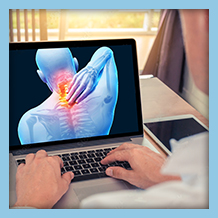

Most individuals with neck problems don’t require any surgery. But, if non-surgical approaches fail to control issues or pain you’re experiencing, your spine surgeon may recommend you have your neck problem treated with a posterior cervical fusion.
What is a Posterior Cervical Fusion?
PCF is a procedure where the surgeon surgically mends two (or more) of the bones in your cervical spine along the side of the bones by using a back of the neck (posterior) incision. They’ll place a bone graft along the sides of your spine bones, which fuse them over time. The surgeon may perform PCF with or without posterior decompression and use metal rods/screws.
These days, metal rods and screws are typically used, increasing the fusion rate (the percentage of individuals who have had the bone fuse together successfully) and adding immediate stability. It’s generally reserved for individuals who have issues with the spine bones of their neck instead of a problem with the cervical disc between them. The surgeon may recommend PCF to individuals with a cervical:
- Instability
- Fracture, such as a broken cervical vertebra)
- Deformity, such as cervical kyphosis)
- Infection tumors, such as bone cancer
Chances are, you won’t even know you require PCF until your doctor informs you. But, individuals with metastatic cancer, neck trauma, or large neck curve deviations have a higher chance of requiring posterior cervical fusion than others.
What To Expect During a Posterior Cervical Fusion?
You’ll be under general anesthesia while the surgeon performs the procedure. They’ll place an endotracheal tube (breathing tube) which helps you breathe during surgery with a ventilator. You’ll be provided with preoperative intravenous antibiotics. They’ll position you on your stomach, typically on a unique bed or table with special supports and padding.
The surgeon will cleanse the surgical neck area with a unique cleaning solution. They’ll place sterile drapes and wear clean surgical attire, such as gloves and gowns, to maintain an environment free of bacteria. The surgeon will make a three to six-inch posterior incision (depending on the number of levels) in the midline, straight over the affected spinal levels. They’ll gently divide the muscle and fascia to expose the spine bones and spinous processes. They’ll obtain an X-ray to confirm the proper spinal levels they need to fuse.
The surgeon may or may not perform a foraminotomy (removes the bone spurs close to the area where the nerve comes through the spine bone hole) and laminectomy (removes the bone’s lamina portion), depending on if it’s needed or not. They may affix two small metal screws to each spine bone on each side, which then are attached with a rod (titanium metal) on both sides of the spine. They’ll then decorticate the facet joints and bony surfaces and place a bone graft which fuses over time.
They’ll wash out the wound area with sterile water containing antibiotics and close the deep subcutaneous and fascial layers with strong sutures. They’ll also use sutures or staples to close the skin and apply a sterile bandage. The entire surgery is two to four hours long, depending on how many spinal levels are involved.
Are There Any PCF Complications?
All surgeries have certain potential risks for bleeding, infection, or anesthesia difficulties — posterior cervical fusion isn’t any different. Specific PCF complications include continued pain or instability of the neck, perhaps due to the bones not correctly knitting together (i.e., pseudoarthrosis).
Because the spine surgeon is performing the surgery near your nerve roots and spinal cord, PCF complications can also include numbness, weakness, or nerve injury. You’ll want to sit down and discuss all potential risks with your spine surgeon before your procedure.
What to Expect After Posterior Cervical Disc Fusion?
You can plan on staying in the hospital for several days following a posterior cervical fusion procedure. Most surgeons will have you wear a neck brace while you’re recovering. This brace will help keep your neck and head in the correct position so your spine bones can fuse adequately. You’ll be limited on what activities you’re allowed to do for a few weeks after your procedure, and you’ll likely be given pain medication to help control your pain.
You’ll need to schedule a follow-up appointment with the surgeon around two weeks after your procedure. They may increase your activity level (i.e., desk work, meal preparation) if you heal well.
You won’t be able to perform any physical work or drive for four to six weeks following your PCF procedure. Therefore, you’ll want to make sure you’ve made arrangements. After around six weeks of recovery, your spine surgeon will want to conduct an examination and take new X-rays of your neck to confirm the spine bones have correctly fused. You should be able to get back to most of your everyday activities if your bones are fusing well.
Reach Out to Orthopedic and Laser Spine Surgery in Florida for your Neck Pain
It would be best if you didn’t have to live with pain, regardless of where it is. If you’re experiencing neck pain, you’ll want to consult with our team here at Orthopedic Laser Spine Surgery in Florida about whether or not you should consider posterior cervical infusion or if another treatment approach would be more appropriate for your specific situation
Our neck and back specialists team will customize your treatment approach, whether PCF or not, to ensure you have the best possible chance of recovery. Call us today at (855) 853-6542 or fill out our contact form on our website to schedule your initial consultation.
